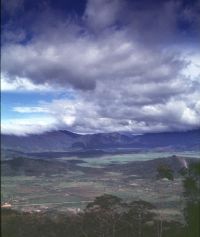Ekari language
You can help expand this article with text translated from the corresponding article in Portuguese. (May 2022) Click [show] for important translation instructions.
|
| Ekari | |
|---|---|
| Mee | |
| Native to | Indonesia |
| Region | Papua |
| Ethnicity | Ekari |
Native speakers | (100,000 cited 1985)[1] |
| Language codes | |
| ISO 639-3 | ekg |
| Glottolog | ekar1243 |

Ekari (also Ekagi, Kapauku, Mee) is a Trans–New Guinea language spoken by about 100,000 people in the Paniai lakes region of the Indonesian province of Central Papua, including the villages of Enarotali, Mapia and Moanemani. This makes it the second-most populous Papuan language in Indonesian New Guinea after Western Dani. Language use is vigorous. Documentation is quite limited.
Phonology
[edit]Consonants
[edit]| Bilabial | Alveolar | Palatal | Velar | ||
|---|---|---|---|---|---|
| Nasal | m | n | |||
| Plosive | plain | p | t | k | |
| voiced | b | d | ɡᶫ | ||
| Approximant | w | j | |||
The voiced velar stop /ɡᶫ/ is pronounced with lateral release. Doble describes both /k/ and /ɡᶫ/ as being labialized [kʷ, ɡᶫʷ] after the back vowels /o, u/ (i.e., okei 'they', euga 'more'), with /g/ having 'varying' degrees of the lateral.[2] Staroverov & Tebay describe /ɡᶫ/ as being velar lateral [ɡᶫ] before front vowels and uvular non-lateral [ɢʶ] before non-front vowels. When lateral, there is usually a stop onset, but occasionally just [ʟ] is heard.[3]
/j/ is a "more palatalized [ʒ]" (perhaps [ʝ] or [ʑ]) before the high front vowel /i/ (e.g., yina 'insect').[2]
Vowels
[edit]Both Doble (1987) and Staroverov & Tebay (2019) describe five vowel qualities. Long vowels and diphthongs are analyzed as sequences.
| front | central | back | |
|---|---|---|---|
| high | i | u | |
| mid | ɛ | o | |
| low | a |
Tone
[edit]Ekari has pitch accent. One syllable in a word may have a high tone, contrasting with words without a high tone. If the vowel is long or a diphthong and not at the end of the word, the high tone is phonetically rising.
CV words have no tone contrast. CVV words may be mid/low or high. (In all of these patterns, here and following, initial C is optional.)
Words of the following shapes may have a contrastive high tone on the final syllable: CVCV, CVCVV. Words of the following shapes may have either a rising or a falling tone on the first long syllable: CVVCV, CVVCVV, CVCVVCVV, CVVCVCV (rare), CVVCVCVV (rare). The following word shapes do not have contrastive tone: CVCVCV, CVCVVCV, CVCVCVV, and words of 4 or more syllables.
References
[edit]- ^ Ekari at Ethnologue (25th ed., 2022)

- ^ a b Doble (1987)
- ^ Staroverov & Tebay 2019.
Bibliography
[edit]- Doble, Marion (1962). Essays on Kapauku grammar. Nieuw Guinea Studiën. Vol. 6. pp. 152–155, 211–218, 279–298.
- Doble, Marion (1987). "A description of some features of Ekari language structure". Oceanic Linguistics. 26 (1/2): 55–113. doi:10.2307/3623166. JSTOR 3623166.
- Drabbe, Peter (1952). Spraakkunst van het Ekagi, Wisselmeren, Nederlands Nieuw Guinea (in Dutch). Den Haag: Martinus Nijhoff.
- Steltenpool, J (1969). Ekagi-Dutch-English-Indonesian Dictionary. VKI 56. The Hague: Martinus Nijhoff.
- Staroverov, Peter; Tebay, Sören E. (2019). "Posterior Affricate in Mee and Consonant-Vowel Place Interactions". Proceedings of the Annual Meetings on Phonology. 7. doi:10.3765/amp.v7i0.4481.
External links
[edit]Materials on Ekari are included in the open access Arthur Capell collections held by Paradisec: